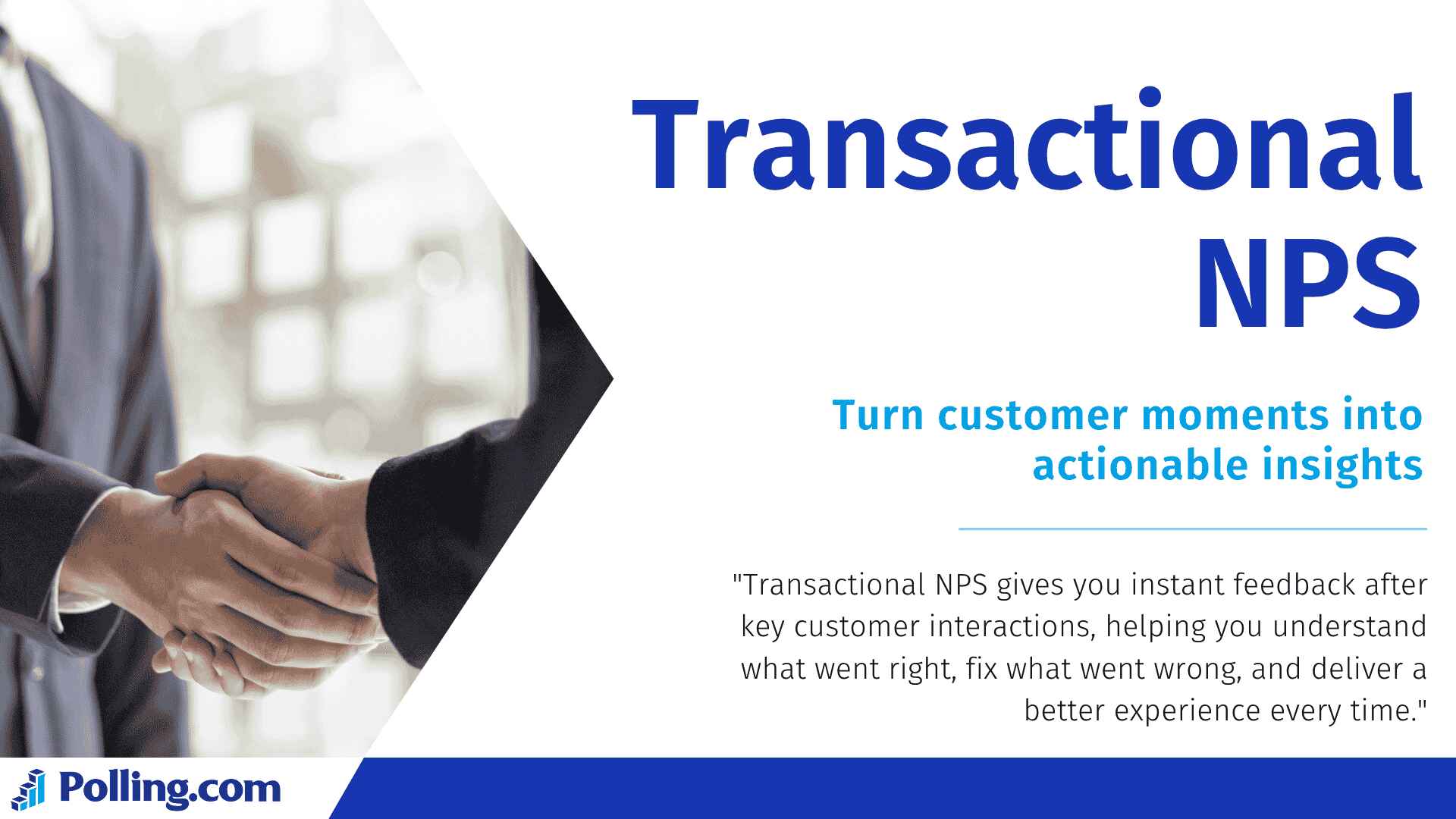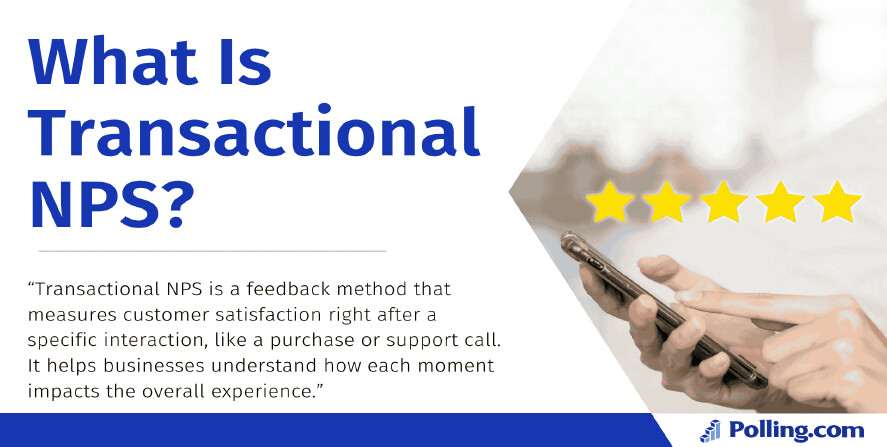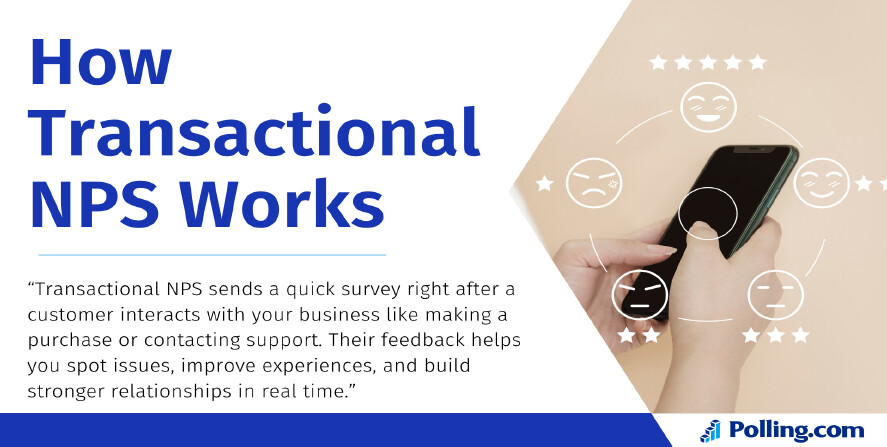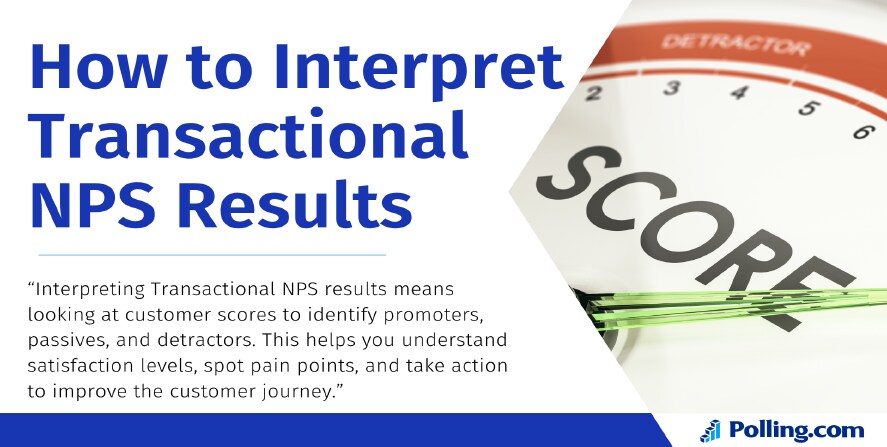
Transactional NPS Helps You Improve Customer Experience
Transactional NPS is a fast and simple way to find out how customers feel right after they use your service or buy something.
Think about a time when you had a poor experience with a business and decided not to go back. In many cases, just one negative interaction can drive customers away. That’s why it’s essential to capture their feelings as soon as possible. If you wait weeks or even months to ask for feedback, it’s usually too late.
With transactional NPS, you can quickly send a short survey right after customers talk to support, place an order, or use your app. As a result, their feedback shows what went well and what needs improvement. Consequently, this allows you to address issues faster and boost customer satisfaction.
What Is Transactional NPS?

Transactional NPS is a method to measure how satisfied customers are following a specific interaction. For example, it allows you to quickly gather feedback immediately after a service call, purchase, or app use. Instead of waiting weeks to hear from customers, you get their thoughts instantly. This helps you fix problems fast and improve their experience.
Definition of Transactional Net Promoter Score (NPS)
Transactional NPS, also called tNPS, is a short survey sent to customers after they interact with your company. The main question is:
“Based on your recent experience, how likely are you to suggest our service to someone you know?”
This question focuses on the customer’s most recent experience, not their overall opinion. It’s a key part of npsmanagement strategies and fits within the broader nps definition net promoter score.
Comparison with Relationship NPS
While tNPS looks at one specific interaction, Relationship NPS (rNPS) checks the overall relationship with your brand. Here’s a simple comparison:
| Feature | Transactional NPS | Relationship NPS |
|---|---|---|
| Focus | One experience | Whole relationship |
| When Sent | After interaction | Every few months |
| Purpose | Improve a moment | Track brand loyalty |
| Feedback Type | Detailed and timely | General and long-term |
Why Post-Interaction Feedback Matters
When you gather feedback immediately after an experience, you’ll gain more accurate and useful insights. As a result, you can:
- Spot issues right away
- Improve customer service
- See how each part of the customer journey works
How Transactional NPS Works

Trigger Points for Surveys
You can send Transactional NPS surveys at different moments. These are some common trigger points:
- After Customer Support Calls Find out if the issue was solved and if the customer is happy with the agent.
- After a Purchase Learn if checkout was smooth and if the customer got what they needed.
- During App or Digital Interactions Ask for feedback after users complete tasks in your app or software.
Survey Delivery Methods
To get more responses, use several ways to send your surveys:
- Email Surveys: These are especially useful for follow-ups after customers make purchases or contact support.
- In-App Pop-Ups Perfect for software tools. Customers can reply while they’re still in your app.
- SMS Messages Quick and easy, especially for mobile-first users. SMS has high open rates.
Why Use Transactional NPS?
Real-Time Feedback Benefits
Using transactional NPS gives you a huge advantage. Here’s how:
- Fast Insights: As a result, you quickly discover what’s working and what’s not.
- Better Customer Experience: Because you can address issues immediately, your customers become happier and more satisfied.
- More Accurate Feedback Since the experience just happened, feedback is fresh and honest.
Case Example: SaaS Company XYZ
XYZ Software used a nps survey tool after every customer support ticket. They discovered that:
- Many unhappy users waited too long for help.
- Happy users loved how knowledgeable the agents were.
As a result, XYZ hired more staff and gave better training. After one month:
- NPS scores rose by 30%
- Customer retention increased by 15%
This shows how nps software can drive real improvements when used well.
Transactional NPS vs Relationship NPS
Key Differences
Let’s break down the main differences:
- Scope
- Transactional NPS: Specific experiences
- Relationship NPS: General feeling about the company
- Timing
- tNPS: After a single touchpoint
- rNPS: Scheduled regularly (like every quarter)
- Use Cases
- tNPS: Fix short-term problems
- rNPS: Plan long-term strategy
How to Use Both Together
Using both types of NPS gives you a full view. Here’s how:
- tNPS helps you spot and fix daily issues
- rNPS shows long-term trends
When combined, they create a complete nps program that covers every part of the customer journey.
Designing Effective Transactional NPS Surveys
Best Practices
To get the most value, design your survey carefully.
- Send It Right Away Timing matters. Ask for feedback as soon as the interaction ends.
- Keep It Simple: For example, ask a straightforward question like, ‘How likely are you to recommend us based on this experience?’
- Add a Follow-Up Question: Additionally, ask customers why they gave their score, because this helps you understand the context.
Survey Design Mistakes to Avoid
Let’s look at some frequent mistakes and ways to prevent them.:
- Survey Fatigue Don’t ask too often. Customers will stop responding.
- Leading Questions Avoid pushing people to answer in a certain way.
- Technical Issues Test your survey on phones, tablets, and browsers to avoid delivery problems.
How to Interpret Transactional NPS Results

Scoring Explained
NPS scores range from 0 to 10. Here’s what each score means:
- Promoters (9–10): Loyal fans who recommend your brand
- Passives (7–8): Happy but not loyal
- Detractors (0–6): Unsatisfied customers who may share negative opinions with others.
Formula: % of Promoters − % of Detractors = NPS
Feedback Analysis
Look beyond the number. Use your nps tools to:
- Find patterns by location or department
- Sort feedback into themes
- Spot trends over time using visual dashboards in your net promoter score software
Taking Action on Transactional NPS Feedback
Close the Loop with Respondents
Follow up with customers. It builds trust and shows you care.
- Use Automation for Detractors Send an apology email or a discount code.
- Add a Human Touch Have a real person reach out for serious issues.
- Thank Promoters Ask them to leave a review or share their experience.
Drive Continuous Improvement
To improve constantly, do this:
- Share feedback with your teams
- Use your nps survey software to track updates
- Align improvements with what your customers say they need
Best Platforms for Transactional NPS Surveys
Why Polling.com is the Best Option

Polling.com is a smart choice for net promoter software. Here’s why:
- Real-Time Delivery and Insights Get feedback instantly and act fast.
- CRM and Help Desk Integration It works with tools like Salesforce and Zendesk.
- Easy to Use and Scalable From startups to enterprises, it fits all sizes.
Comparison with Other Tools
Here’s how Polling.com compares to others:
| Tool | Strength | Weakness | Best For |
|---|---|---|---|
| Polling.com | Fast and real-time | Fewer filters | All business sizes |
| Delighted | Easy to use | Less customization | Small teams |
| Qualtrics | Deep analytics | Expensive | Large enterprises |
| SurveyMonkey | Many survey types | Limited NPS tools | General surveys |
Overall, Polling.com stands out as the best nps software for companies focused on improving customer experience quickly.
Common Mistakes to Avoid
Avoid these traps when using nps survey tools:
- Over-Surveying Don’t ask too often. Pick key moments to ask.
- Ignoring Detractors These are the people you can learn the most from.
- Looking Only at the Score Read the comments. The number doesn’t tell the whole story.
Conclusion: Unlocking the Power of Transactional NPS
In summary, Transactional NPS gives you quick, clear feedback when it matters most. It helps you:
- Improve experiences in real time
- Spot problems before they grow
- Build trust by acting on feedback
Whether you’re using a net promoter score tool for your ecommerce store or a nps tool for your SaaS product, real-time feedback is the future of great customer service.
Try Polling.com today. It’s one of the best nps survey tools available easy to use, full of features, and made for teams who care about customer experience.
